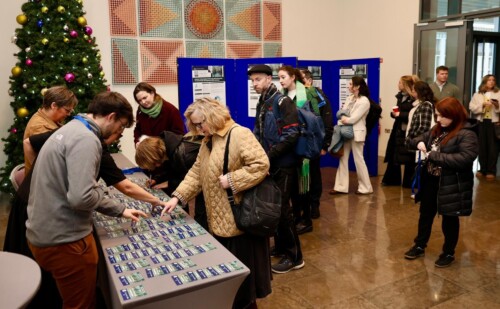HEA Statistics Newsletter 9th Edition

HEA Statistics
Posted: 11 March, 2024

Welcome to the latest edition of the HEA Statistics Newsletter. In this edition, we will take you through our latest pieces of news, starting with our recent
HEA Conference on ‘Exploring Student Progression in Higher Education’, the latest Non-Progression Report and Dashboard, some interesting facts for International Women’s Day, and the March SRS returns. We also have a survey on our newsletter if you would like to offer us some feedback.
Alternatively, you can let us know your thoughts by contacting us at statisticsnews@hea.ie
If you would like to follow our social media platforms, the links are also below. You can sign up to receive this newsletter directly to your inbox by following the link below.
HEA Conference on ‘Exploring Student Progression in Higher Education’ in Croke Park, 29 February
The HEA hosted a one-day conference on 29 February 2024 in Croke Park to launch the latest 2021/2022 new entrant non-progression data. The aim of the conference was to bridge the gap between data and policy, and leverage insight to inform policy discussions on student success. Moreover, the intention was to create a forum for higher education institutions and stakeholders to share their learnings, their interventions, and to drive an agenda for change by examining and understanding the factors behind progression and non-progression.
The conference brought together key stakeholders from the Irish Higher Education sector, the Further Education and Post-Primary sectors, the Organisation for Economic Co-operation and Development (OECD), and the UK’s Higher Education Policy Institute (HEPI), to discuss these latest figures and to consider strategies to enable student progression. A series of Policy Workshops were held with a view to informing future HEA policy in this area. Specifically, these focused on the key areas of student success and student experience, belonging and connectedness, HE pathways and transitions, and teaching, learning and assessment.
To view the presentation, visit the Conference information site below.
HEA Conference information site
Latest Non-Progression Report and Dashboard
Progression rates relate to the percentage of first year full-time undergraduate new entrants who continue in their studies the following academic year. The latest report, relating to 2021/2022 new entrants. The latest report, relating to 2021/2022 new entrants, reveal that the latest progression rate is 85%, down from 88% in 2020/21.
The HEA began tracking and reporting on student progression in 2007. Since then, there have been significant advances in the higher education system’s knowledge and understanding of student progression and the factors influencing progression rates in Ireland.
This has enabled the identification of cohorts who have a higher risk of non-progression in higher education. These include entrants who identify as male, entrants coming from disadvantaged areas, and entrants with lower Leaving Certificate points on entry.
The key findings of the latest report include:
- In 2021/22, the non-progression rate was 15%. In 2020/21, this was 12%, representing an increase of 3 percentage points.
- By NFQ Level, Level 7 entrants had the highest non-progression rate, at 31%, followed by Level 6 entrants at 25%, and Level 8 entrants at 14%.
- Services has the highest non-progression rate at 28%. This is followed by Engineering, Manufacturing & Construction at 20%.
- Between 2020/21 and 2021/22, Services has seen the largest increase in non-progression rate, from 21% in 2020/21 to 28% in 2021/22.
- Non-progression rates are highest amongst disadvantaged students, at 23%, and lowest amongst affluent students (12%).
- In 2021/22, females had a non-progression rate of 13%, while males had a non-progression rate of 18%.
Non-Progression Report and Dashboard
International Women’s Day 2024
In celebration of IWD, we want to share some statistics about women that we have found from our Student and Graduate data.
- The county with the highest percentage of female enrolments in the academic year 2022/2023 was Mayo, with 58% of the students from Mayo being women.
- In the academic year 2022/2023, over 50% of the students in all counties were female, with an average of 55% across all higher education institutions being women.
- In 2022/2023, ‘Health and Welfare’ and ‘Education’ were the fields of study with the highest percentage of female enrolments, with 76% and 75% of all enrolments being women.
- Conversely, ‘Information and Communication Technologies’ and ‘Engineering, Manufacturing, and Construction’ had the lowest percentage of female enrolments, with 23% and 24% respectively.
- The field of study with the highest percentage of female graduates in 2022 was ‘Health and Welfare’ with 79% of the students being women, while the field of study with the lowest percentage was ‘Engineering, Manufacturing and Construction’ with only 25% of the graduates being women.
- Finally, the county with the highest percentage of female graduates in 2022 was Monaghan with 64% of the graduates being women, while the lowest percentage was in Limerick with 54%.
March 2024 SRS returns
The Student Record System (SRS) is now open and accepting data for the 2023/2024 academic year.
The final SRS return is submitted to the HEA by each individual higher education institution in March of each year. The onus is on each institution to ensure data quality, and integrity of the SRS returns. The HEA conducts extensive audits on these SRS returns, and data is signed off by each HEI. The SRS contains data on two cohorts:
- Student Cohort: Those who are actively in the process of completing a programme in the current academic year.
- Graduate Cohort: Those who have successfully completed a program in the preceding academic year.
The HEA aims to release the 2023/2024 data through the ‘Key Facts and Figures’, an online interactive dashboard, in Q4 2024; and 2023/2024 data will also be available to access and download in Q4 via the ‘Access our Data’ section on the website
And if you have any comments, feedback or suggestions for future newsletters, please do let us know at statisticsnews@hea.ie!


